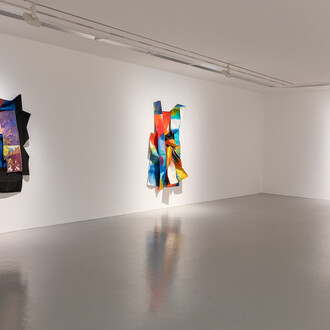Anthony Murphy – True Light opens with an exhibition of 40 works by the artist. His first solo show with the gallery, it highlights Anthony’s passion for light and life.
Born in Buenos Aires in 1956 and educated at Westminster School, London, Anthony’s first flourish in the arts saw him win an Emmy in 1973 for Best Actor in Tom Brown’s Schooldays. After which he wen to study Philosphy, Psychology and Physiology at Oxford and later the letter of the law.
Called to the Bar in 1984, he practiced in both London and Paris. Marriage to the Duke of Devonshire’s daughter and a rather ‘social’ life in London and Paris, took its toll. In 1990 Anthony gave up law and began his quest for sanctuary. He arrived in Clifden, a place he visited many times in his youth, to live with his uncle Richard Murphy, poet, at the home to his ancestors. Since moving to France in 1992, Anthony has exhibited his work from Chelsea to San Francisco.
The works in this exhibition reveal his desire for the light and colours of his home in Carcassonne and his passion for the Irish landscape. From the mauve twilight of spring with it faint hint of rain in the air to the gathering of turf for winter fires, the artist, revealed in the confident stokes of his paintings, shows us the moving narrative of life.
From the Artist:
From where I live on a clear morning one can see the ruined walls of the Château de Montségur. It was there that on 16th March 1244, 225 Cathar Parfaits chose to be burnt at the stake rather than renounce their dualist faith and went singing, freely, to their auto-da-fé. It is a haunting memory which always serves as a reminder that beliefs are an integral part of existence.
The problem for the Cathars, and for many others, has always been interference by other people. But today at least in the French Department of Aude, and equally in county Galway Ireland, the desolation and wildness make no claim on me, and I am left free to develop my painting in accordance with my beliefs.
In both France and Ireland I go and sit in a bar or brasserie. A painter in the corner of a bar in Ireland is treated like a slow-witted conjuror, someone about whom one can’t be too sure; in France the reaction is more respectful. The smoker will blow smoke rings, and the waiter will study the influences in your work with feigned indifference.
My father and his brother passed on to me their love of Ireland. My father restored a ruined castle, Carraigin, on Lough Corrib, where I go to paint; and my uncle Richard Murphy lived and worked as a poet in Cleggan, on the west coast. After Oxford, I went out to live in county Galway. For three seasons I hunted with the Galway Blazers, and took aerial photographs from a microlight. Much of my understanding of imagery had its beginning at that time. I can still see Micky Dempsey’s pink coat against the dark brown bogs of Attymon.
Trial and error are my great masters. A painting is nothing more or less than a series of brush strokes; and of each stroke one may say: “If you like it, leave it; if you don’t, wipe it off.” In my search for colours that move, much of a picture will end up as rags around my feet. Why some people are painters seems partly to do with this persistent desire to correct and alter the image. This persistence and tenacity can suggest that the completed image exists somewhere already, in the way Plato proposed. In fact a quiet hope of mine is to discover, on death, that the heavenly substance from which, say, all pears draw their “pearness”, looks a bit like one of my paintings.
Montreal d’Aude, France
Catalogues for this exhibition are available from the gallery.



















